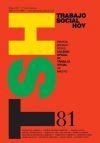Participación en centros de ocio y tiempo libre para personas mayores: La incidencia de soledad y determinantes demográficos
[Participation in activity centres for the elderly: the incidence of loneliness and demographic factors]
Autoría: Jimeno Jiménez, Fernando(1); Martín Segura, José Aurelio(2)
Datos profesionales del autor/a: (1)IMSERSO
(2)Universidad de Granada
(2)Universidad de Granada
Correspondencia: Fernando Jimeno Jiménez presta servicios en IMSERSO. Email: fernandom.jimeno@gmail.com. José Aureliano Martín Segura, profesor Ayudante Doctor del Departamento de Organización de Empresas de la Universidad de Granada y Profesor en el Centro Asociado de la UNED en Ceuta. Email: aurelianomartin@ugr.es.
Recibido: 12/2/2017
Revisado: 23/3/2017
Aceptado: 20/4/2017
Publicado: 31/5/2017
Resumen
El objetivo de esta investigación es analizar cómo influyen determinadas circunstancias en la evolución de los centros sociales, hogares de mayores, recursos asistenciales destinados al ocio y tiempo libre. Se utiliza un modelo predictivo de datos de panel durante el periodo 1999/2010. Obtienen significación con coeficiente positivo la aproximación de la situación de soledad de la persona mayor, el indicador de población residente en ámbito rural y la esperanza de vida; con coeficiente negativo, la variable que representa la población con 80 años y más.
Descarga del artículo:
Palabras Clave
Personas mayores, Centros sociales de mayores, Situación de soledad, Determinantes.
Abstract
The aim of this research is to analyse how certain circumstances influence the evolution of activity centres, homes for the elderly and care resources devoted to leisure activities. A predictive model based on panel data gathered between 1999 and 2010 is used. The following variables are found to be significant with a positive co-efficient: approximation of the elderly person"s situation of loneliness, the population living in rural areas indicator and life expectancy. Significance with a negative co-efficient is obtained by the variable that represents population aged 80 years and older.
Key words: Seniors, Elderly people, Activity Centres for the Elderly, Situations of loneliness, Determining factors.
Key words: Seniors, Elderly people, Activity Centres for the Elderly, Situations of loneliness, Determining factors.
Key Words
Seniors, Elderly people, Activity Centres for the Elderly, Situations of loneliness, Determining factors.
Referencia Normalizada (cómo citar este artículo)
Jimeno, F., y Martín-Segura, J. A. (2017). Participación en centros de ocio y tiempo libre para personas mayores: La incidencia de soledad y determinantes demográficos. Trabajo Social Hoy, 81,7-18. doi: 10.12960/TSH.2017.0007.
Texto del Artículo
Referencias
Agulló Tomás, M. S. (2001). Mayores, actividad y trabajo en el proceso de envejecimiento y jubilación: una aproximación psico-sociológica. Madrid. IMSERSO.
Bueno, B. y Buz, J. (2006). Jubilación y tiempo libre en la vejez. IMSERSO, Portal Mayores, Informes Portal Mayores, 65.
Calvin, C.M., Batty, G.D., Brett, C.E. y Dery, I.J. (2015). Childhood club participation and all cause mortality in adulthood: A 65 year follow up study of a population representative sample in Scotland. Psichosom Med., 77 (7), 712-720.
Cattan, M., White, M., Bond, J. y Le Armouth, A. (2005). Preventing social isolation and loneliness among older people: a systemtic review of health promotion interventions. Ageing and society, 25 (1), 41-67. http://dx.doi.org/10.1017/S0144686X04002594
Durán, M. A. (2011). Las personas mayores en el medio rural y urbano. Libro Blanco del Envejecimiento Activo. IMSERSO, 461- 494.
Ekstrom, H., Dahlin, I., S y Elmstahl, S. (2013). Does informal support influence social participation of fractured elderly people?. Archives of gerontology and geriatrics, 56 (3), 457- 465. http://dx.doi.org/10.1016/j.archger.2012.11.010
Glass, T.A., Mendes, C., Marottolli, R. y Berkman, L.(1999). Population based study of social and productive activities as predictors of survival among elderly Americans. BMJ, 319, 478-83. http://dx.doi.org/10.1136/bmj.319.7208.478
Gott, M., Barnes, S., Payne, S., Parker, C., Seamark, D., Gariballa, S. y Small, N. (2007). Patient views of social service provision for older people with advanced heart failure. Health and social care in the community, 15 (4), 333-342. http://dx.doi.org/10.1111/j.1365-2524.2007.00689.x
Hámel, K. (2016). Making nursing homes more community-oriented: insights from an exploratory study in Germany. Ageing and Society, 36 (4), 673-693. http://dx.doi.org/10.1017/S0144686X14001391
Hemingway, A. y Jack, E. (2013). Reducing social isolation and promoting well being in older people. Quality in ageing and older adults, 14 (1), 25-35. http://dx.doi.org/10.1108/14717791311311085
Holt-Lunstad J, Smith TB, Layton JB. (2010). Social relationships and mortality risk: a meta-analytic review. PLoS Med., 7 (7). Published on line 2010 Jul 27. 10.1371/journal.pmed.1000316 http://dx.doi.org/10.1371/journal.pmed.1000316
House, J.S., Landis K.R. y Umberson D. (1988). Social relationships and health. Science, 241: 540–545. http://dx.doi.org/10.1126/science.3399889
Hsu, H.C. (2007). Does social participation by the elderly reduce mortality and cognitive impairment? Aging Ment Health, 11, 699-707. http://dx.doi.org/10.1080/13607860701366335
Iglesias de Ussel, J. (Dir.) (2001). La soledad de las personas mayores: Influencias personales, familiares y sociales. Análisis cualitativo. Madrid. IMSERSO.
IMSERSO. (2007a). A propósito de las condiciones de vida de las personas mayores. Encuesta 2006. Observatorio de las Personas Mayores. Madrid. IMSERSO.
IMSERSO. (2007b). Uso del tiempo libre en las personas mayores. Perfiles y tendencias, 27. Madrid. IMSERSO.
IMSERSO. (2010). Encuesta sobre personas mayores. Madrid. IMSERSO. www.imserso.es
IMSERSO. (2011). El libro blanco del envejecimiento activo. Madrid. IMSERSO.
IMSERSO. (2014). Informe 2014. Las personas mayores en España. Datos estadísticos nacionales y por Comunidades Autónomas. Madrid. IMSERSO.
Ishikawa, Y. et al. (2016). Social participation and mortality: does social position in civic groups matter? BMC Public health, 12 (16), 394.
Jimeno, F. y Martín, J. A. (2016). Condiciones de vida y cuidados profesionales destinados a personas mayores en España. Revista de Responsabilidad Social de la Empresa RSE, 23, 105-131.
Leitner, S. (2003). Varieties of familialism: the caring function of the family in comparative perspective. European Societies, 5 (4), 353-375. http://dx.doi.org/10.1080/1461669032000127642
Rodríguez, V., Fernández, G. y Rojo, F. (2012). Una vejez activa en España. Grupo de Población del CSIC.
Rogero García, J. (2010). Los tiempos del cuidado. Impacto de la dependencia de los mayores en la vida cotidiana de sus cuidadores. Madrid. IMSERSO.
Routasalo, E., Savikko, N., Tilvis, R. S., Strandberg, T. E. y Pitka, K. H. (2006). Social contacts and their relationship to loneliness among aged people – a population-based study. Gerontology, 52, (3), 181-187. http://dx.doi.org/10.1159/000091828
Rubio Herrera, R. (2011). La influencia de la soledad en las formas de vida convivencia de los mayores. Libro Blanco del Envejecimiento Activo. IMSERSO, 527-533.
Takagi D., Kondo K. y Kawachi I. (2013). Social participation and mental health: moderating effects of gender, social role and rurality. BMC Public Health, 13, 701. http://dx.doi.org/10.1186/1471-2458-13-701
Thorslund, M., Norström, T. y Wernberg, K. (1991). The utilization of home help in Sweden: a multivariate analysis. The gerontologist, 31 (1), 116-119. http://dx.doi.org/10.1093/geront/31.1.116
Van Baarsen, B., Snijders, T.A.B., Smit, J.H. y Van Duijn, M.A.J. (2001). Lonely but not alone: emotional isolation and social isolation as two distinct dimensions of loneliness in older people. Educational and Psychological Measurement, 61,119-135. http://dx.doi.org/10.1177/00131640121971103
Victor, C., Scambler, S., Bond, J. y Bowling, A. (2000). Being alone in later life: loneliness, social isolation and living alone. Reviews in Clinical. Gerontology, 10, 407-417. http://dx.doi.org/10.1017/S0959259800104101
York, E. (2014). Social Resources and Disordered Living Conditions: Evidence from a National Sample of Community-Residing Older Adults. Res Aging, 36 (4), 399-430.
Bueno, B. y Buz, J. (2006). Jubilación y tiempo libre en la vejez. IMSERSO, Portal Mayores, Informes Portal Mayores, 65.
Calvin, C.M., Batty, G.D., Brett, C.E. y Dery, I.J. (2015). Childhood club participation and all cause mortality in adulthood: A 65 year follow up study of a population representative sample in Scotland. Psichosom Med., 77 (7), 712-720.
Cattan, M., White, M., Bond, J. y Le Armouth, A. (2005). Preventing social isolation and loneliness among older people: a systemtic review of health promotion interventions. Ageing and society, 25 (1), 41-67. http://dx.doi.org/10.1017/S0144686X04002594
Durán, M. A. (2011). Las personas mayores en el medio rural y urbano. Libro Blanco del Envejecimiento Activo. IMSERSO, 461- 494.
Ekstrom, H., Dahlin, I., S y Elmstahl, S. (2013). Does informal support influence social participation of fractured elderly people?. Archives of gerontology and geriatrics, 56 (3), 457- 465. http://dx.doi.org/10.1016/j.archger.2012.11.010
Glass, T.A., Mendes, C., Marottolli, R. y Berkman, L.(1999). Population based study of social and productive activities as predictors of survival among elderly Americans. BMJ, 319, 478-83. http://dx.doi.org/10.1136/bmj.319.7208.478
Gott, M., Barnes, S., Payne, S., Parker, C., Seamark, D., Gariballa, S. y Small, N. (2007). Patient views of social service provision for older people with advanced heart failure. Health and social care in the community, 15 (4), 333-342. http://dx.doi.org/10.1111/j.1365-2524.2007.00689.x
Hámel, K. (2016). Making nursing homes more community-oriented: insights from an exploratory study in Germany. Ageing and Society, 36 (4), 673-693. http://dx.doi.org/10.1017/S0144686X14001391
Hemingway, A. y Jack, E. (2013). Reducing social isolation and promoting well being in older people. Quality in ageing and older adults, 14 (1), 25-35. http://dx.doi.org/10.1108/14717791311311085
Holt-Lunstad J, Smith TB, Layton JB. (2010). Social relationships and mortality risk: a meta-analytic review. PLoS Med., 7 (7). Published on line 2010 Jul 27. 10.1371/journal.pmed.1000316 http://dx.doi.org/10.1371/journal.pmed.1000316
House, J.S., Landis K.R. y Umberson D. (1988). Social relationships and health. Science, 241: 540–545. http://dx.doi.org/10.1126/science.3399889
Hsu, H.C. (2007). Does social participation by the elderly reduce mortality and cognitive impairment? Aging Ment Health, 11, 699-707. http://dx.doi.org/10.1080/13607860701366335
Iglesias de Ussel, J. (Dir.) (2001). La soledad de las personas mayores: Influencias personales, familiares y sociales. Análisis cualitativo. Madrid. IMSERSO.
IMSERSO. (2007a). A propósito de las condiciones de vida de las personas mayores. Encuesta 2006. Observatorio de las Personas Mayores. Madrid. IMSERSO.
IMSERSO. (2007b). Uso del tiempo libre en las personas mayores. Perfiles y tendencias, 27. Madrid. IMSERSO.
IMSERSO. (2010). Encuesta sobre personas mayores. Madrid. IMSERSO. www.imserso.es
IMSERSO. (2011). El libro blanco del envejecimiento activo. Madrid. IMSERSO.
IMSERSO. (2014). Informe 2014. Las personas mayores en España. Datos estadísticos nacionales y por Comunidades Autónomas. Madrid. IMSERSO.
Ishikawa, Y. et al. (2016). Social participation and mortality: does social position in civic groups matter? BMC Public health, 12 (16), 394.
Jimeno, F. y Martín, J. A. (2016). Condiciones de vida y cuidados profesionales destinados a personas mayores en España. Revista de Responsabilidad Social de la Empresa RSE, 23, 105-131.
Leitner, S. (2003). Varieties of familialism: the caring function of the family in comparative perspective. European Societies, 5 (4), 353-375. http://dx.doi.org/10.1080/1461669032000127642
Rodríguez, V., Fernández, G. y Rojo, F. (2012). Una vejez activa en España. Grupo de Población del CSIC.
Rogero García, J. (2010). Los tiempos del cuidado. Impacto de la dependencia de los mayores en la vida cotidiana de sus cuidadores. Madrid. IMSERSO.
Routasalo, E., Savikko, N., Tilvis, R. S., Strandberg, T. E. y Pitka, K. H. (2006). Social contacts and their relationship to loneliness among aged people – a population-based study. Gerontology, 52, (3), 181-187. http://dx.doi.org/10.1159/000091828
Rubio Herrera, R. (2011). La influencia de la soledad en las formas de vida convivencia de los mayores. Libro Blanco del Envejecimiento Activo. IMSERSO, 527-533.
Takagi D., Kondo K. y Kawachi I. (2013). Social participation and mental health: moderating effects of gender, social role and rurality. BMC Public Health, 13, 701. http://dx.doi.org/10.1186/1471-2458-13-701
Thorslund, M., Norström, T. y Wernberg, K. (1991). The utilization of home help in Sweden: a multivariate analysis. The gerontologist, 31 (1), 116-119. http://dx.doi.org/10.1093/geront/31.1.116
Van Baarsen, B., Snijders, T.A.B., Smit, J.H. y Van Duijn, M.A.J. (2001). Lonely but not alone: emotional isolation and social isolation as two distinct dimensions of loneliness in older people. Educational and Psychological Measurement, 61,119-135. http://dx.doi.org/10.1177/00131640121971103
Victor, C., Scambler, S., Bond, J. y Bowling, A. (2000). Being alone in later life: loneliness, social isolation and living alone. Reviews in Clinical. Gerontology, 10, 407-417. http://dx.doi.org/10.1017/S0959259800104101
York, E. (2014). Social Resources and Disordered Living Conditions: Evidence from a National Sample of Community-Residing Older Adults. Res Aging, 36 (4), 399-430.





